Nursing Assignment: Applying the TTM Model to Patient Dietary Habits
VerifiedAdded on 2022/08/18
|8
|2047
|19
Report
AI Summary
This report applies the Transtheoretical Model of Behavior Change (TTM) to a 45-year-old male patient, Mr. X, struggling with poor eating habits, which puts him at risk for high cholesterol and cardiovascular disease. The paper identifies Mr. X's current stage in the TTM as contemplation, where he is aware of his unhealthy diet but is ambivalent about change. The report details his family history of hypertension and diabetes, highlighting the need for dietary modifications. The rationale emphasizes the benefits of behavioral counseling and dietary interventions in preventing cardiovascular disease. The essay discusses the stages of TTM, the processes of change, and the importance of motivation and readiness for change. It proposes a nurse-led intervention, including nutrition education, goal setting, and self-efficacy enhancement, to move Mr. X from contemplation to preparation and action stages. The intervention includes regular feedback to address barriers and promote adherence to positive health behaviors, with the ultimate goal of reducing his risk factors and promoting long-term health.
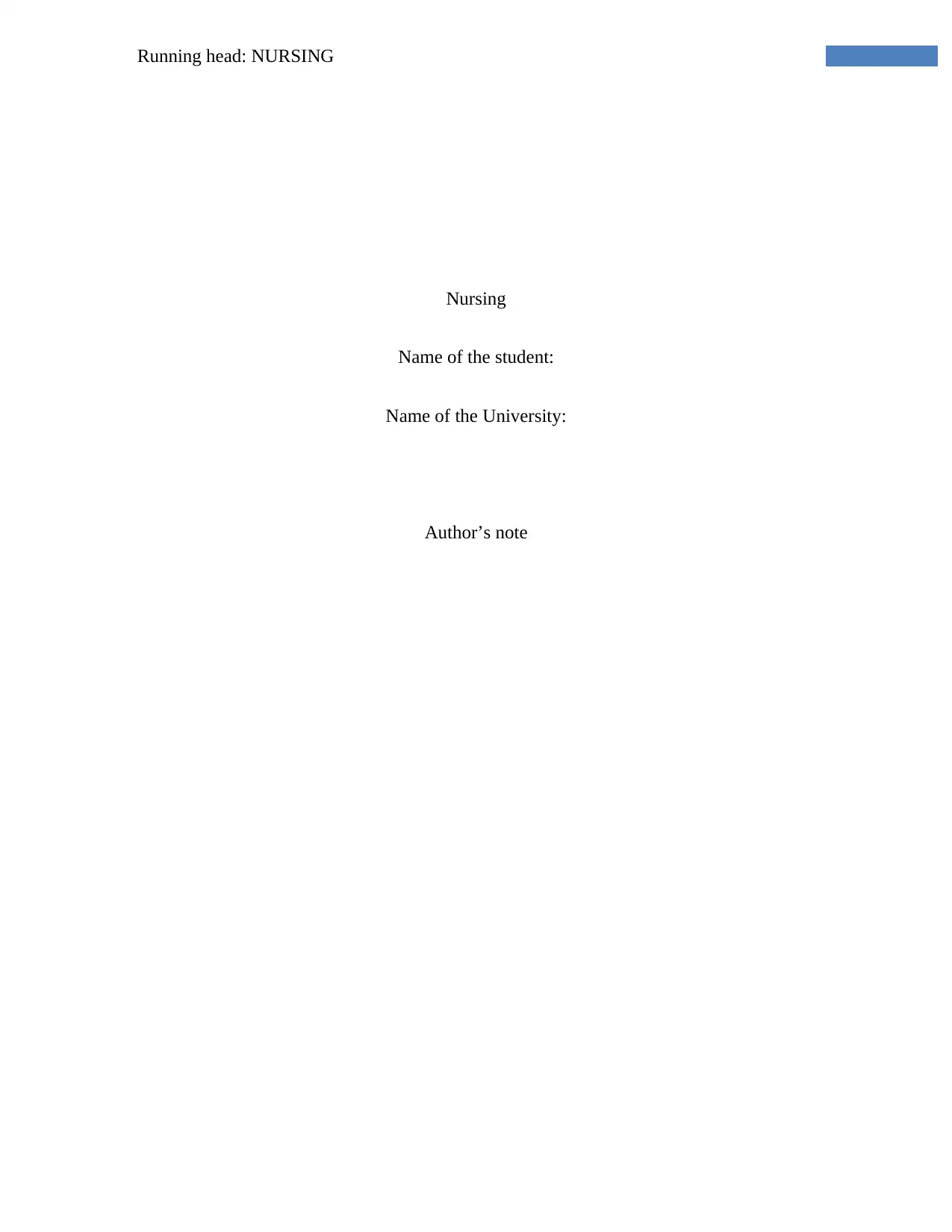
Running head: NURSING
Nursing
Name of the student:
Name of the University:
Author’s note
Nursing
Name of the student:
Name of the University:
Author’s note
Paraphrase This Document
Need a fresh take? Get an instant paraphrase of this document with our AI Paraphraser
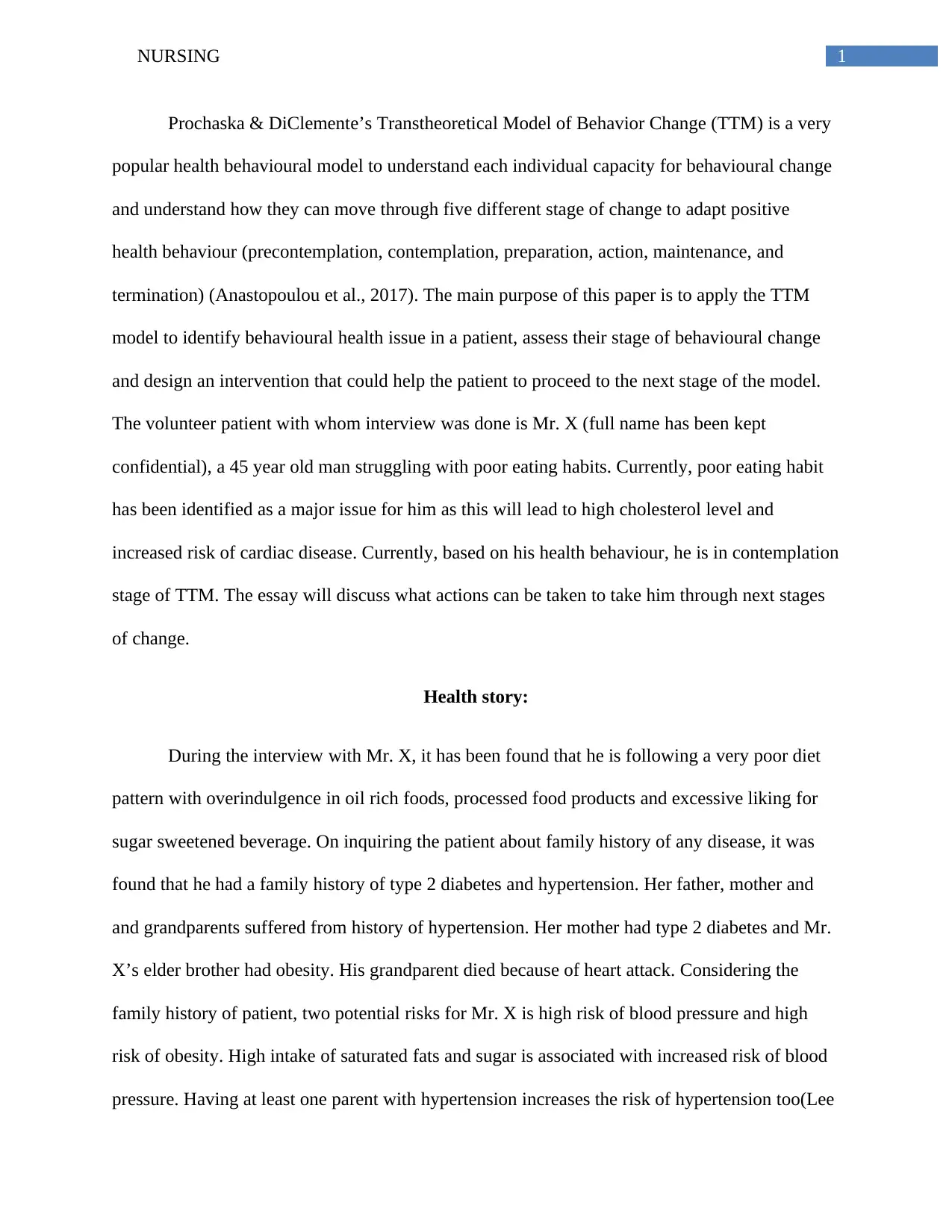
1NURSING
Prochaska & DiClemente’s Transtheoretical Model of Behavior Change (TTM) is a very
popular health behavioural model to understand each individual capacity for behavioural change
and understand how they can move through five different stage of change to adapt positive
health behaviour (precontemplation, contemplation, preparation, action, maintenance, and
termination) (Anastopoulou et al., 2017). The main purpose of this paper is to apply the TTM
model to identify behavioural health issue in a patient, assess their stage of behavioural change
and design an intervention that could help the patient to proceed to the next stage of the model.
The volunteer patient with whom interview was done is Mr. X (full name has been kept
confidential), a 45 year old man struggling with poor eating habits. Currently, poor eating habit
has been identified as a major issue for him as this will lead to high cholesterol level and
increased risk of cardiac disease. Currently, based on his health behaviour, he is in contemplation
stage of TTM. The essay will discuss what actions can be taken to take him through next stages
of change.
Health story:
During the interview with Mr. X, it has been found that he is following a very poor diet
pattern with overindulgence in oil rich foods, processed food products and excessive liking for
sugar sweetened beverage. On inquiring the patient about family history of any disease, it was
found that he had a family history of type 2 diabetes and hypertension. Her father, mother and
and grandparents suffered from history of hypertension. Her mother had type 2 diabetes and Mr.
X’s elder brother had obesity. His grandparent died because of heart attack. Considering the
family history of patient, two potential risks for Mr. X is high risk of blood pressure and high
risk of obesity. High intake of saturated fats and sugar is associated with increased risk of blood
pressure. Having at least one parent with hypertension increases the risk of hypertension too(Lee
Prochaska & DiClemente’s Transtheoretical Model of Behavior Change (TTM) is a very
popular health behavioural model to understand each individual capacity for behavioural change
and understand how they can move through five different stage of change to adapt positive
health behaviour (precontemplation, contemplation, preparation, action, maintenance, and
termination) (Anastopoulou et al., 2017). The main purpose of this paper is to apply the TTM
model to identify behavioural health issue in a patient, assess their stage of behavioural change
and design an intervention that could help the patient to proceed to the next stage of the model.
The volunteer patient with whom interview was done is Mr. X (full name has been kept
confidential), a 45 year old man struggling with poor eating habits. Currently, poor eating habit
has been identified as a major issue for him as this will lead to high cholesterol level and
increased risk of cardiac disease. Currently, based on his health behaviour, he is in contemplation
stage of TTM. The essay will discuss what actions can be taken to take him through next stages
of change.
Health story:
During the interview with Mr. X, it has been found that he is following a very poor diet
pattern with overindulgence in oil rich foods, processed food products and excessive liking for
sugar sweetened beverage. On inquiring the patient about family history of any disease, it was
found that he had a family history of type 2 diabetes and hypertension. Her father, mother and
and grandparents suffered from history of hypertension. Her mother had type 2 diabetes and Mr.
X’s elder brother had obesity. His grandparent died because of heart attack. Considering the
family history of patient, two potential risks for Mr. X is high risk of blood pressure and high
risk of obesity. High intake of saturated fats and sugar is associated with increased risk of blood
pressure. Having at least one parent with hypertension increases the risk of hypertension too(Lee
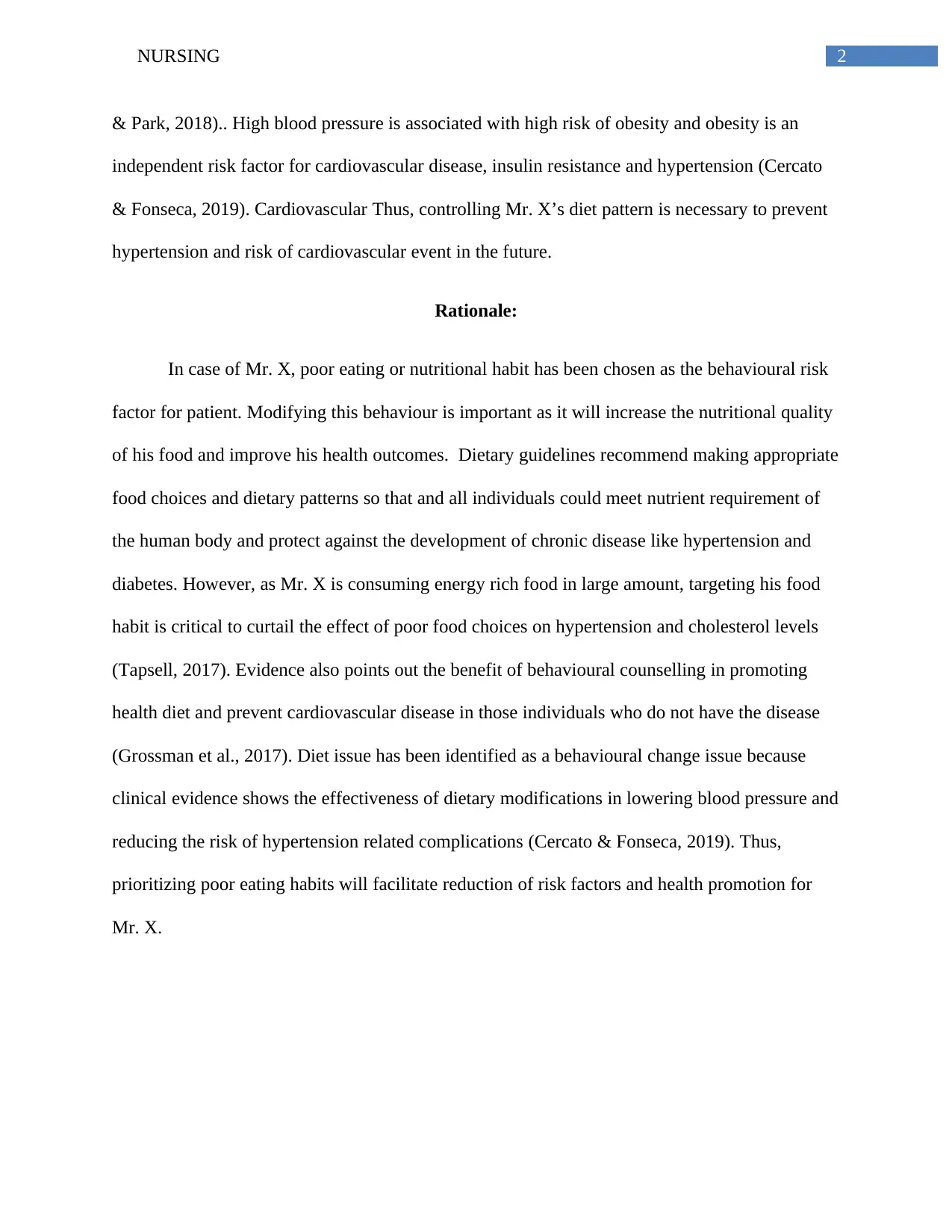
2NURSING
& Park, 2018).. High blood pressure is associated with high risk of obesity and obesity is an
independent risk factor for cardiovascular disease, insulin resistance and hypertension (Cercato
& Fonseca, 2019). Cardiovascular Thus, controlling Mr. X’s diet pattern is necessary to prevent
hypertension and risk of cardiovascular event in the future.
Rationale:
In case of Mr. X, poor eating or nutritional habit has been chosen as the behavioural risk
factor for patient. Modifying this behaviour is important as it will increase the nutritional quality
of his food and improve his health outcomes. Dietary guidelines recommend making appropriate
food choices and dietary patterns so that and all individuals could meet nutrient requirement of
the human body and protect against the development of chronic disease like hypertension and
diabetes. However, as Mr. X is consuming energy rich food in large amount, targeting his food
habit is critical to curtail the effect of poor food choices on hypertension and cholesterol levels
(Tapsell, 2017). Evidence also points out the benefit of behavioural counselling in promoting
health diet and prevent cardiovascular disease in those individuals who do not have the disease
(Grossman et al., 2017). Diet issue has been identified as a behavioural change issue because
clinical evidence shows the effectiveness of dietary modifications in lowering blood pressure and
reducing the risk of hypertension related complications (Cercato & Fonseca, 2019). Thus,
prioritizing poor eating habits will facilitate reduction of risk factors and health promotion for
Mr. X.
& Park, 2018).. High blood pressure is associated with high risk of obesity and obesity is an
independent risk factor for cardiovascular disease, insulin resistance and hypertension (Cercato
& Fonseca, 2019). Cardiovascular Thus, controlling Mr. X’s diet pattern is necessary to prevent
hypertension and risk of cardiovascular event in the future.
Rationale:
In case of Mr. X, poor eating or nutritional habit has been chosen as the behavioural risk
factor for patient. Modifying this behaviour is important as it will increase the nutritional quality
of his food and improve his health outcomes. Dietary guidelines recommend making appropriate
food choices and dietary patterns so that and all individuals could meet nutrient requirement of
the human body and protect against the development of chronic disease like hypertension and
diabetes. However, as Mr. X is consuming energy rich food in large amount, targeting his food
habit is critical to curtail the effect of poor food choices on hypertension and cholesterol levels
(Tapsell, 2017). Evidence also points out the benefit of behavioural counselling in promoting
health diet and prevent cardiovascular disease in those individuals who do not have the disease
(Grossman et al., 2017). Diet issue has been identified as a behavioural change issue because
clinical evidence shows the effectiveness of dietary modifications in lowering blood pressure and
reducing the risk of hypertension related complications (Cercato & Fonseca, 2019). Thus,
prioritizing poor eating habits will facilitate reduction of risk factors and health promotion for
Mr. X.
⊘ This is a preview!⊘
Do you want full access?
Subscribe today to unlock all pages.

Trusted by 1+ million students worldwide
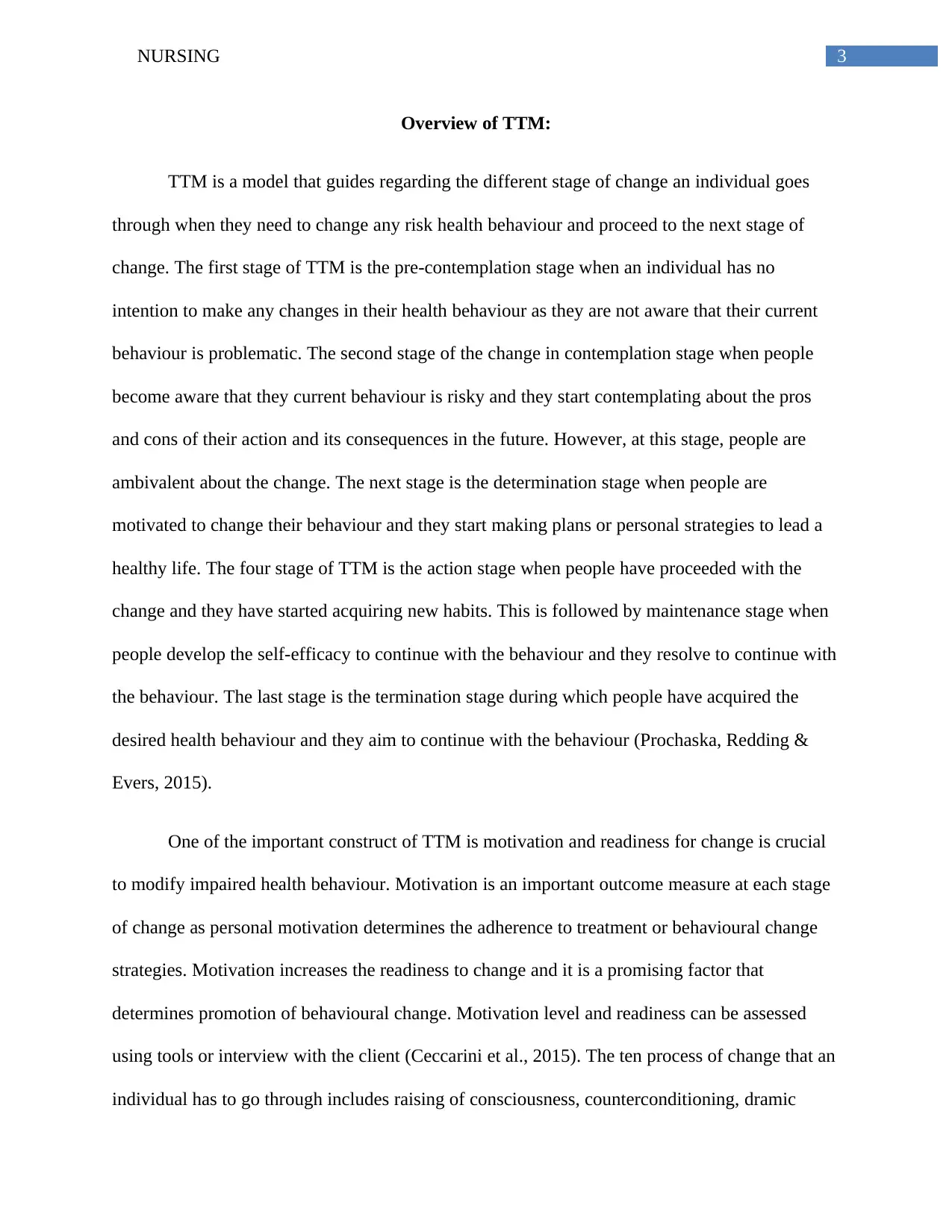
3NURSING
Overview of TTM:
TTM is a model that guides regarding the different stage of change an individual goes
through when they need to change any risk health behaviour and proceed to the next stage of
change. The first stage of TTM is the pre-contemplation stage when an individual has no
intention to make any changes in their health behaviour as they are not aware that their current
behaviour is problematic. The second stage of the change in contemplation stage when people
become aware that they current behaviour is risky and they start contemplating about the pros
and cons of their action and its consequences in the future. However, at this stage, people are
ambivalent about the change. The next stage is the determination stage when people are
motivated to change their behaviour and they start making plans or personal strategies to lead a
healthy life. The four stage of TTM is the action stage when people have proceeded with the
change and they have started acquiring new habits. This is followed by maintenance stage when
people develop the self-efficacy to continue with the behaviour and they resolve to continue with
the behaviour. The last stage is the termination stage during which people have acquired the
desired health behaviour and they aim to continue with the behaviour (Prochaska, Redding &
Evers, 2015).
One of the important construct of TTM is motivation and readiness for change is crucial
to modify impaired health behaviour. Motivation is an important outcome measure at each stage
of change as personal motivation determines the adherence to treatment or behavioural change
strategies. Motivation increases the readiness to change and it is a promising factor that
determines promotion of behavioural change. Motivation level and readiness can be assessed
using tools or interview with the client (Ceccarini et al., 2015). The ten process of change that an
individual has to go through includes raising of consciousness, counterconditioning, dramic
Overview of TTM:
TTM is a model that guides regarding the different stage of change an individual goes
through when they need to change any risk health behaviour and proceed to the next stage of
change. The first stage of TTM is the pre-contemplation stage when an individual has no
intention to make any changes in their health behaviour as they are not aware that their current
behaviour is problematic. The second stage of the change in contemplation stage when people
become aware that they current behaviour is risky and they start contemplating about the pros
and cons of their action and its consequences in the future. However, at this stage, people are
ambivalent about the change. The next stage is the determination stage when people are
motivated to change their behaviour and they start making plans or personal strategies to lead a
healthy life. The four stage of TTM is the action stage when people have proceeded with the
change and they have started acquiring new habits. This is followed by maintenance stage when
people develop the self-efficacy to continue with the behaviour and they resolve to continue with
the behaviour. The last stage is the termination stage during which people have acquired the
desired health behaviour and they aim to continue with the behaviour (Prochaska, Redding &
Evers, 2015).
One of the important construct of TTM is motivation and readiness for change is crucial
to modify impaired health behaviour. Motivation is an important outcome measure at each stage
of change as personal motivation determines the adherence to treatment or behavioural change
strategies. Motivation increases the readiness to change and it is a promising factor that
determines promotion of behavioural change. Motivation level and readiness can be assessed
using tools or interview with the client (Ceccarini et al., 2015). The ten process of change that an
individual has to go through includes raising of consciousness, counterconditioning, dramic
Paraphrase This Document
Need a fresh take? Get an instant paraphrase of this document with our AI Paraphraser
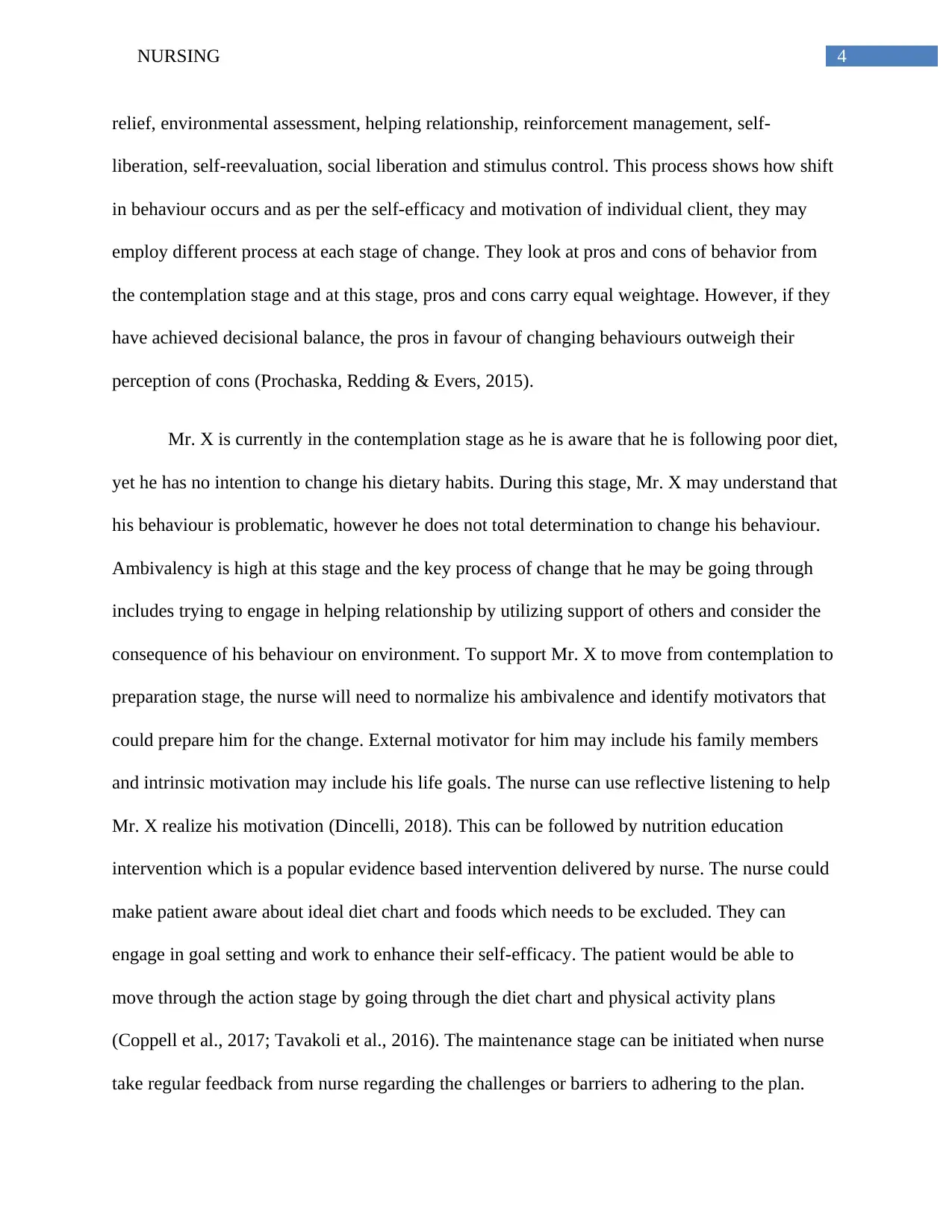
4NURSING
relief, environmental assessment, helping relationship, reinforcement management, self-
liberation, self-reevaluation, social liberation and stimulus control. This process shows how shift
in behaviour occurs and as per the self-efficacy and motivation of individual client, they may
employ different process at each stage of change. They look at pros and cons of behavior from
the contemplation stage and at this stage, pros and cons carry equal weightage. However, if they
have achieved decisional balance, the pros in favour of changing behaviours outweigh their
perception of cons (Prochaska, Redding & Evers, 2015).
Mr. X is currently in the contemplation stage as he is aware that he is following poor diet,
yet he has no intention to change his dietary habits. During this stage, Mr. X may understand that
his behaviour is problematic, however he does not total determination to change his behaviour.
Ambivalency is high at this stage and the key process of change that he may be going through
includes trying to engage in helping relationship by utilizing support of others and consider the
consequence of his behaviour on environment. To support Mr. X to move from contemplation to
preparation stage, the nurse will need to normalize his ambivalence and identify motivators that
could prepare him for the change. External motivator for him may include his family members
and intrinsic motivation may include his life goals. The nurse can use reflective listening to help
Mr. X realize his motivation (Dincelli, 2018). This can be followed by nutrition education
intervention which is a popular evidence based intervention delivered by nurse. The nurse could
make patient aware about ideal diet chart and foods which needs to be excluded. They can
engage in goal setting and work to enhance their self-efficacy. The patient would be able to
move through the action stage by going through the diet chart and physical activity plans
(Coppell et al., 2017; Tavakoli et al., 2016). The maintenance stage can be initiated when nurse
take regular feedback from nurse regarding the challenges or barriers to adhering to the plan.
relief, environmental assessment, helping relationship, reinforcement management, self-
liberation, self-reevaluation, social liberation and stimulus control. This process shows how shift
in behaviour occurs and as per the self-efficacy and motivation of individual client, they may
employ different process at each stage of change. They look at pros and cons of behavior from
the contemplation stage and at this stage, pros and cons carry equal weightage. However, if they
have achieved decisional balance, the pros in favour of changing behaviours outweigh their
perception of cons (Prochaska, Redding & Evers, 2015).
Mr. X is currently in the contemplation stage as he is aware that he is following poor diet,
yet he has no intention to change his dietary habits. During this stage, Mr. X may understand that
his behaviour is problematic, however he does not total determination to change his behaviour.
Ambivalency is high at this stage and the key process of change that he may be going through
includes trying to engage in helping relationship by utilizing support of others and consider the
consequence of his behaviour on environment. To support Mr. X to move from contemplation to
preparation stage, the nurse will need to normalize his ambivalence and identify motivators that
could prepare him for the change. External motivator for him may include his family members
and intrinsic motivation may include his life goals. The nurse can use reflective listening to help
Mr. X realize his motivation (Dincelli, 2018). This can be followed by nutrition education
intervention which is a popular evidence based intervention delivered by nurse. The nurse could
make patient aware about ideal diet chart and foods which needs to be excluded. They can
engage in goal setting and work to enhance their self-efficacy. The patient would be able to
move through the action stage by going through the diet chart and physical activity plans
(Coppell et al., 2017; Tavakoli et al., 2016). The maintenance stage can be initiated when nurse
take regular feedback from nurse regarding the challenges or barriers to adhering to the plan.
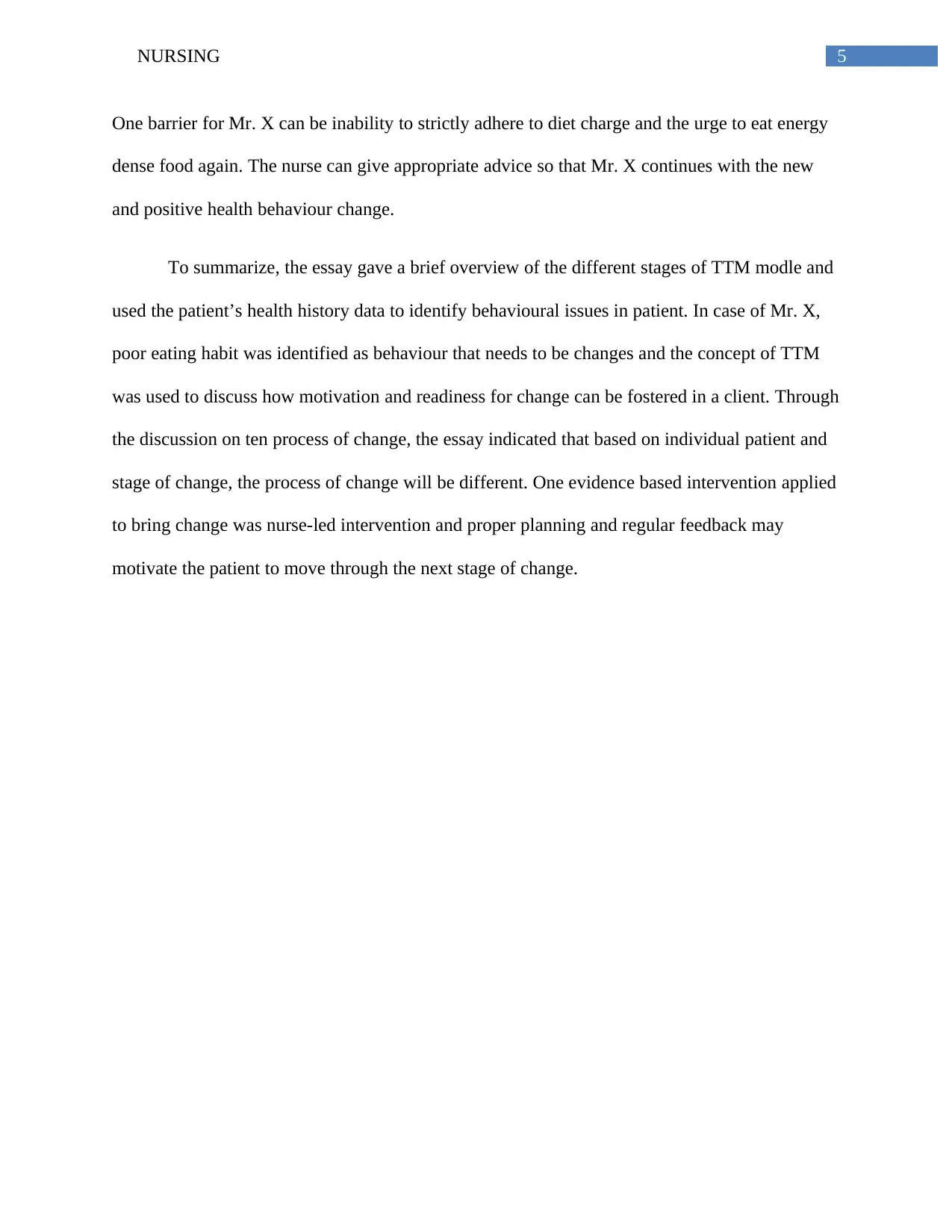
5NURSING
One barrier for Mr. X can be inability to strictly adhere to diet charge and the urge to eat energy
dense food again. The nurse can give appropriate advice so that Mr. X continues with the new
and positive health behaviour change.
To summarize, the essay gave a brief overview of the different stages of TTM modle and
used the patient’s health history data to identify behavioural issues in patient. In case of Mr. X,
poor eating habit was identified as behaviour that needs to be changes and the concept of TTM
was used to discuss how motivation and readiness for change can be fostered in a client. Through
the discussion on ten process of change, the essay indicated that based on individual patient and
stage of change, the process of change will be different. One evidence based intervention applied
to bring change was nurse-led intervention and proper planning and regular feedback may
motivate the patient to move through the next stage of change.
One barrier for Mr. X can be inability to strictly adhere to diet charge and the urge to eat energy
dense food again. The nurse can give appropriate advice so that Mr. X continues with the new
and positive health behaviour change.
To summarize, the essay gave a brief overview of the different stages of TTM modle and
used the patient’s health history data to identify behavioural issues in patient. In case of Mr. X,
poor eating habit was identified as behaviour that needs to be changes and the concept of TTM
was used to discuss how motivation and readiness for change can be fostered in a client. Through
the discussion on ten process of change, the essay indicated that based on individual patient and
stage of change, the process of change will be different. One evidence based intervention applied
to bring change was nurse-led intervention and proper planning and regular feedback may
motivate the patient to move through the next stage of change.
⊘ This is a preview!⊘
Do you want full access?
Subscribe today to unlock all pages.

Trusted by 1+ million students worldwide
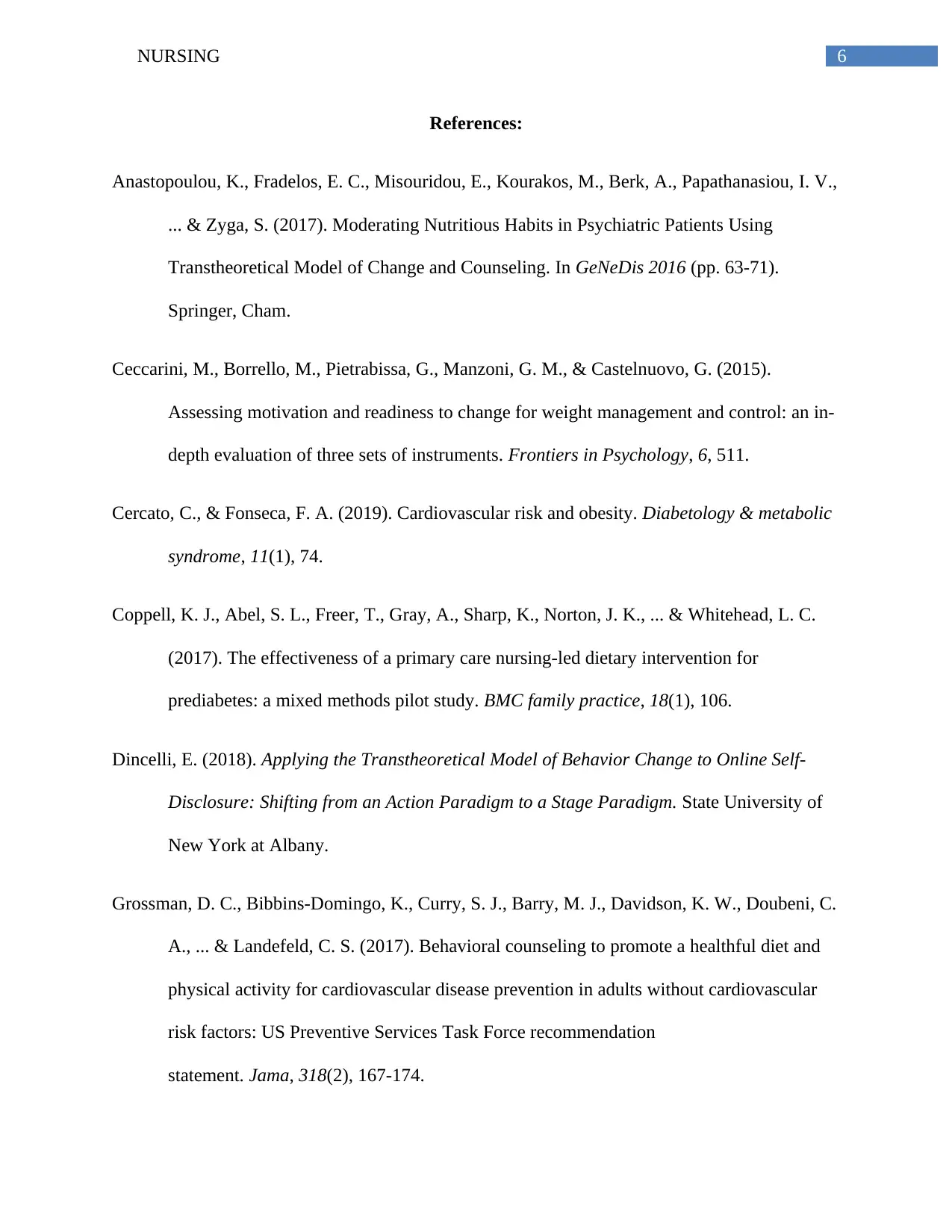
6NURSING
References:
Anastopoulou, K., Fradelos, E. C., Misouridou, E., Kourakos, M., Berk, A., Papathanasiou, I. V.,
... & Zyga, S. (2017). Moderating Nutritious Habits in Psychiatric Patients Using
Transtheoretical Model of Change and Counseling. In GeNeDis 2016 (pp. 63-71).
Springer, Cham.
Ceccarini, M., Borrello, M., Pietrabissa, G., Manzoni, G. M., & Castelnuovo, G. (2015).
Assessing motivation and readiness to change for weight management and control: an in-
depth evaluation of three sets of instruments. Frontiers in Psychology, 6, 511.
Cercato, C., & Fonseca, F. A. (2019). Cardiovascular risk and obesity. Diabetology & metabolic
syndrome, 11(1), 74.
Coppell, K. J., Abel, S. L., Freer, T., Gray, A., Sharp, K., Norton, J. K., ... & Whitehead, L. C.
(2017). The effectiveness of a primary care nursing-led dietary intervention for
prediabetes: a mixed methods pilot study. BMC family practice, 18(1), 106.
Dincelli, E. (2018). Applying the Transtheoretical Model of Behavior Change to Online Self-
Disclosure: Shifting from an Action Paradigm to a Stage Paradigm. State University of
New York at Albany.
Grossman, D. C., Bibbins-Domingo, K., Curry, S. J., Barry, M. J., Davidson, K. W., Doubeni, C.
A., ... & Landefeld, C. S. (2017). Behavioral counseling to promote a healthful diet and
physical activity for cardiovascular disease prevention in adults without cardiovascular
risk factors: US Preventive Services Task Force recommendation
statement. Jama, 318(2), 167-174.
References:
Anastopoulou, K., Fradelos, E. C., Misouridou, E., Kourakos, M., Berk, A., Papathanasiou, I. V.,
... & Zyga, S. (2017). Moderating Nutritious Habits in Psychiatric Patients Using
Transtheoretical Model of Change and Counseling. In GeNeDis 2016 (pp. 63-71).
Springer, Cham.
Ceccarini, M., Borrello, M., Pietrabissa, G., Manzoni, G. M., & Castelnuovo, G. (2015).
Assessing motivation and readiness to change for weight management and control: an in-
depth evaluation of three sets of instruments. Frontiers in Psychology, 6, 511.
Cercato, C., & Fonseca, F. A. (2019). Cardiovascular risk and obesity. Diabetology & metabolic
syndrome, 11(1), 74.
Coppell, K. J., Abel, S. L., Freer, T., Gray, A., Sharp, K., Norton, J. K., ... & Whitehead, L. C.
(2017). The effectiveness of a primary care nursing-led dietary intervention for
prediabetes: a mixed methods pilot study. BMC family practice, 18(1), 106.
Dincelli, E. (2018). Applying the Transtheoretical Model of Behavior Change to Online Self-
Disclosure: Shifting from an Action Paradigm to a Stage Paradigm. State University of
New York at Albany.
Grossman, D. C., Bibbins-Domingo, K., Curry, S. J., Barry, M. J., Davidson, K. W., Doubeni, C.
A., ... & Landefeld, C. S. (2017). Behavioral counseling to promote a healthful diet and
physical activity for cardiovascular disease prevention in adults without cardiovascular
risk factors: US Preventive Services Task Force recommendation
statement. Jama, 318(2), 167-174.
Paraphrase This Document
Need a fresh take? Get an instant paraphrase of this document with our AI Paraphraser
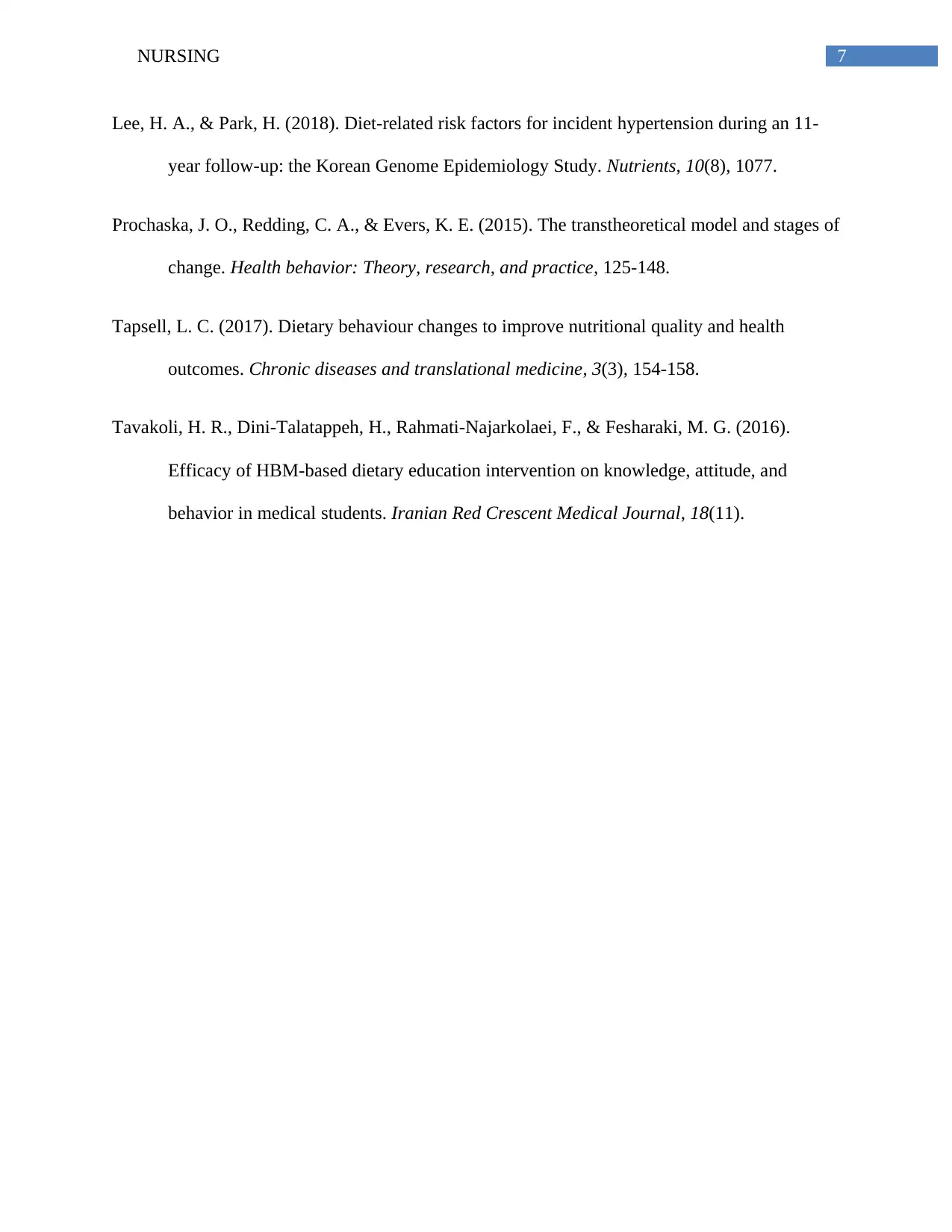
7NURSING
Lee, H. A., & Park, H. (2018). Diet-related risk factors for incident hypertension during an 11-
year follow-up: the Korean Genome Epidemiology Study. Nutrients, 10(8), 1077.
Prochaska, J. O., Redding, C. A., & Evers, K. E. (2015). The transtheoretical model and stages of
change. Health behavior: Theory, research, and practice, 125-148.
Tapsell, L. C. (2017). Dietary behaviour changes to improve nutritional quality and health
outcomes. Chronic diseases and translational medicine, 3(3), 154-158.
Tavakoli, H. R., Dini-Talatappeh, H., Rahmati-Najarkolaei, F., & Fesharaki, M. G. (2016).
Efficacy of HBM-based dietary education intervention on knowledge, attitude, and
behavior in medical students. Iranian Red Crescent Medical Journal, 18(11).
Lee, H. A., & Park, H. (2018). Diet-related risk factors for incident hypertension during an 11-
year follow-up: the Korean Genome Epidemiology Study. Nutrients, 10(8), 1077.
Prochaska, J. O., Redding, C. A., & Evers, K. E. (2015). The transtheoretical model and stages of
change. Health behavior: Theory, research, and practice, 125-148.
Tapsell, L. C. (2017). Dietary behaviour changes to improve nutritional quality and health
outcomes. Chronic diseases and translational medicine, 3(3), 154-158.
Tavakoli, H. R., Dini-Talatappeh, H., Rahmati-Najarkolaei, F., & Fesharaki, M. G. (2016).
Efficacy of HBM-based dietary education intervention on knowledge, attitude, and
behavior in medical students. Iranian Red Crescent Medical Journal, 18(11).
1 out of 8
Related Documents
Your All-in-One AI-Powered Toolkit for Academic Success.
+13062052269
info@desklib.com
Available 24*7 on WhatsApp / Email
![[object Object]](/_next/static/media/star-bottom.7253800d.svg)
Unlock your academic potential
Copyright © 2020–2025 A2Z Services. All Rights Reserved. Developed and managed by ZUCOL.





